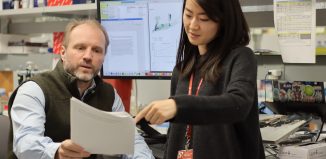CSHL’s Jackson stands tall in maize field
Seeing isn’t just believing — it can also lead to understanding. David Jackson of Cold Spring Harbor Laboratory has developed a way to see just what’s happening with important signals inside the cells of maize, a crop plant that is used in everything from cattle feed to corn syrup to oil, and even glue.
“We want to figure out what’s going on inside the cell: how they respond to treatment or processes,” said Jackson, a professor at Cold Spring Harbor.
Jackson and his collaborators use fluorescence to see proteins and hormones in action. They are not the first to use this technique in living cells, but they are the first to apply it to maize.
Labeling molecules can allow scientists to see where they go “during growth and development,” said Anne Sylvester, a professor in the Molecular Biology department at the University of Wyoming, who worked with Jackson to develop this technique. This allows researchers to see how a protein is regulated, what it’s doing and even suggest ideas on how to control it.
Jackson and Sylvester have made a large collection of these reporter lines and have sent them out to “hundreds of labs,” so other researchers can “use the tools we’ve generated,” Jackson added.
In his lab, Jackson is focused on how the plant establishes and maintains stem cells — which are like blank pieces of biological clay that genes and other molecules can mold into anything in a plant.
At the same time, Jackson and the six post doctoral students in his lab are working on several other projects. In collaboration with Doreen Ware’s lab at Cold Spring Harbor, Jackson has been taking huge amounts of data to explore how genes work together.
“We found connections between different genes we’ve been studying for a long time,” he said. “We didn’t suspect” that link before, but, “in hindsight, it makes perfect sense.”
In a paper published in March in Genome Research, Jackson, Ware, and Andrea Eveland, an assistant member of the Donald Danforth Plant Science Center, among others, showed that the transcription factor Ramosa1 and Knotted1, a regulator of stem cell maintenance, were teaming up to control branching. This, the authors explained in their paper, is an important factor in crop yield, affecting seed number and harvesting ability.
Jackson has “been making great strides in discovery of novel components of stem cell signaling, and translating these findings directly to crop improvement, which really is the ultimate goal of our research as plant scientists,” said Eveland, who worked as a post doctoral student in Jackson’s lab for more than five years.
In addition to analyzing data on genes, Jackson and his lab use Crispr, a tool that is the DNA equivalent of the game Jenga, which can knock out individual pieces, allowing them to see the effect on the plant.
“Many genes are redundant,” he said, so knocking one out doesn’t necessarily change anything because, like a car navigating along a detour, the plant can take an alternate genetic route to arrive at the same destination.
Jackson has won fans among his collaborators. Sarah Hake, the center director of the USDA Plant Gene Expression Center at the University of California at Berkeley, and Jackson’s post doctoral mentor, called him “a superstar.” He has “brilliant ideas” and is “well known in maize genetics and developmental biology.”
He also requires precision and accuracy among his fellow scientists.“When someone showed data at a lab meeting that was poorly done, he would politely call it rubbish,” Hake recalled. “He set a high standard that kept our lab at the top.”
At the same time, Jackson has been an “incredible teacher” and role model to scientists in training. He has contributed to Sylvester’s outreach programs in Montana to help teach genetics and cell biology at a tribal college for Native Americans.
While Jackson doesn’t do any lab bench-work anymore, he conducts field work at a Cold Spring Harbor Laboratory farm during the summer and in Puerto Vallarta in the winter.
Jackson and his wife Kiyomi Tanigawa, an interior designer, live in Brooklyn with their six year-old son, Toma.
Originally from the north of England, Jackson has been at Cold Spring Harbor for 17 years.
In his work, Jackson said he is thrilled with the advances in technology.
“There is a revolution in biology,” he said, adding that Crispr, and other tools, will “open up so many different areas we can address.”






